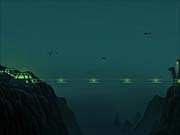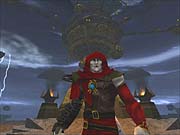Blood Omen 2 Designer Diary #1
Check out the first installment in our Blood Omen 2 designer diaries, straight from the team at Crystal Dynamics.
Entry #1 - 3/8/02
Steve Ross
Lead Artist, Crystal Dynamics

In approaching the look for Blood Omen 2, the first thing we did was look at the original Blood Omen and its sequel Soul Reaver. Our design called for two things that would also influence the look. Most of the game took place in the city of Meridian, and we had this new technology that had been introduced to Nosgoth by the Sarafan Lord--glyph magic, whose markings influence the environment quite significantly. So, while the original Blood Omen had a lot of medieval Germanic-type architecture, Soul Reaver had a much more fantastical look. We chose to start from the original's look and then extrapolated what that style would look like in 200 years under the influence of this new technology. What this meant in effect was that we would start with medieval-type shapes and building materials and then overlay this with newer (although still crude) metal structures. We also wanted to really show that things in Nosgoth had changed, but since it was a vampire game, we still wanted it to be dark and weatherworn. For inspiration, we looked at movies like Bram Stoker's Dracula (Dracula's' castle, specifically), the Batman movies, and City of Lost Children. In designing the game, we imagined Kain moving through a dark city, killing humans and drinking their blood. Because we were developing an engine that would use light maps, we really wanted to push this technology with lots of shapes that would make cool shadows that the player could lurk in--sort of like Jack the Ripper in 1880s London. Another thing that influenced the look of our urban environments was a trip to Paris by a few of us in the art department. We took literally hundreds of pictures!

Our next challenge was to make several environments that had very different looks, while maintaining our baseline "look." This led to creating some really messed-up-looking, practically abandoned areas of the city of Meridian, as well as some more upscale-looking areas. At one point, we even ended up debating how much we wanted each area to have its own unique look and palette. Would it all end up looking like it was one place, or would it look like a bunch of mismatched environments? Remember, it was all basically taking place in one city. In the end, we were pretty happy with the variety we got and how well it all meshed together.
Mostly the locations themselves came from the needs of the design team. To create some fairly new locations that fit better with our needs in Blood Omen 2, we elected to move down the map of Nosgoth into some unexplored areas in the southern regions of Nosgoth.

One thing we did that ended up causing lots of problems is that we created environments that had a good bit of spatial variety, and with that came lots of different-sized areas and elevation changes. What we wanted were large, open plazas offset by tight, twisting alleyways. The elevation changes caused havoc for our path-planning system, and the variety of spaces that Kain could fight in caused hell for the combat system and the camera. It cost us a lot of time because we ended up either rebuilding a lot of the geometry or putting in lots of collision-only geometry. Even though it was painful to get all this stuff to work out, we really like how interesting the areas ended up in the final game.

Making the environments look "lived in" was another goal we had set ourselves. In most of the games we looked at, the environments looked very sterile: Cities had no trash, stains, or other points of interest. We wanted our environments to look gritty and heavy with detail--things like broken walls and fallen masonry. This was one of the things we think we did really well. One of the tools we used that helped us achieve this end was simply creating a library of items that we could sprinkle through the levels. These items even included torn newsprint, rocks, and simple lumps of random garbage. Again, even though we succeeded here, it did cause problems. Every single crate, barrel, piece of garbage, or piece of debris was something that Kain could get stuck on. And he did. We ended up having to go through and check the collision on every single one. Our test department was a huge help in this. If it weren't for them, the game would probably have lost that richness of detail.
Character design was a fairly simple task. After all, we had the original game to look at and then some of the really cool-looking designs from Soul Reaver. The only real challenge was in not going too overboard in following SR's lead. Since the Sarafan Lord had such a strong ruthless dictatorial rule, the basic peasants ended up wearing torn and dirty rags wrapped around them. For the nobility, we came up with something almost looking like Victorian finery. Knights and guards had heavy steal armor. For the vampires, we wanted something that looked a little otherworldly yet elegant and not too far from the styles of the old nobility of Nosgoth (dictated by Kain during his reign). Kain himself starts out in a costume that is a cross between what he wore in the original and the styles worn in Soul Reaver. We saw him as a fallen lord, still wearing what he wore when he fell, but aged and worn around the edges.
Bret Robbins
Writer/Designer, Crystal Dynamics

We wanted the look of Meridian, the city around which Blood Omen 2 takes place, to be significantly different from the typical appearance of other medieval games. Since we were making a game revolving around the culture of the vampire, we thought that a more Victorian feel would be appropriate, with some gothic and steam punk-style thrown in. Soul Reaver was set in Nosgoth's distant future, where the world had decayed due to Kain's decision to destroy the mighty Pillars of Balance. It had the feel of a barren wasteland, but there were also remnants of old technology. Since our game was set centuries before Soul Reaver, it seemed appropriate to show some of this technology in the days of its full operation. Part of our storyline involved the addition of glyph magic to the world, which is a magical energy that essentially acts like electricity flowing throughout the land. The inhabitants of the city were able to build more-advanced machines to better utilize this magic, while other parts of the city were kept much more primitive and dark. In this way we could also justify the addition of a variety of gameplay elements where we saw fit.
In terms of story, we had an interesting challenge. We were part of a larger franchise (the Legacy of Kain series), but we also wanted to separate from that franchise and possibly start a new series. So we wanted the previous games to serve as a backdrop to our game, to provide texture and a common history, but we needed to establish our own story as well. If we were to explain to the player everything that had happened in Blood Omen or in Soul Reaver, it would have taken hours. So we only included some vital bits of history and then moved forward from there, setting up our own back story. Several events take place before the start of our game that did not happen in Blood Omen but that are vital to our story. For example, in the intervening 400 years since Blood Omen, Kain had raised a vampire army to conquer Nosgoth. During this time, the Sarafan, who were an ancient religious order that hunted vampires, had suddenly returned and had begun to gain power throughout the land. Kain fights against the Sarafan and is defeated by their leader, the Sarafan Lord. All of this needed to be explained to the player before the story really starts. We decided to give Kain some slight amnesia so that we could slowly introduce past events to both him and the player. So whenever Kain encounters another vampire from his past, he is told more of the back story. In this way, we didn't have to overload the player with story information right up front. We could dole it out in smaller pieces.
Mike Ellis
Lead Designer, Crystal Dynamics

What makes Nosgoth such an intriguing land is that nothing is ever as simple as black and white. Rarely can things be as clearly definite as good or evil, and nothing can be taken at face value. The general populace is forever mere pawns to be used and abused, as ruthless would-be rulers play out their grand schemes and intricate machinations.
Take, for instance, Kain. In Blood Omen he was tasked to seek out and destroy the guardians of the pillars, who had been driven mad by Nupraptor (the guardian of the Pillar of the Mind). However, in the game's final scene, Kain is given the choice either to sacrifice himself and restore balance to the land or to allow Nosgoth to be corrupted. Kain chooses to rule in hell, so to speak. His course may have been controlled throughout Blood Omen, but as we know, by the time of Soul Reaver, Kain is himself a power player.
By contrast, the Sarafan are an order of warrior priests sworn to purge Nosgoth of the vampire plague and all that is evil. They are holy warriors that represent the humans in what they see as a war for survival. However, in a world that balances on a knife-edge it is easy to intentionally or mistakenly interpret the actions of those they are sworn to protect as evil.Actions that seem brutal and sacrilegious might be for the good of the masses or merely necessary for survival, while those that seem to have good intentions may be the most evil of all.
Actions that seem as brutal and sacrilegious by be for the good of the masses, or merely necessary for survival. Whilst those that seems to have good intentions may be the most evil of all.
Got a news tip or want to contact us directly? Email news@gamespot.com
Join the conversation